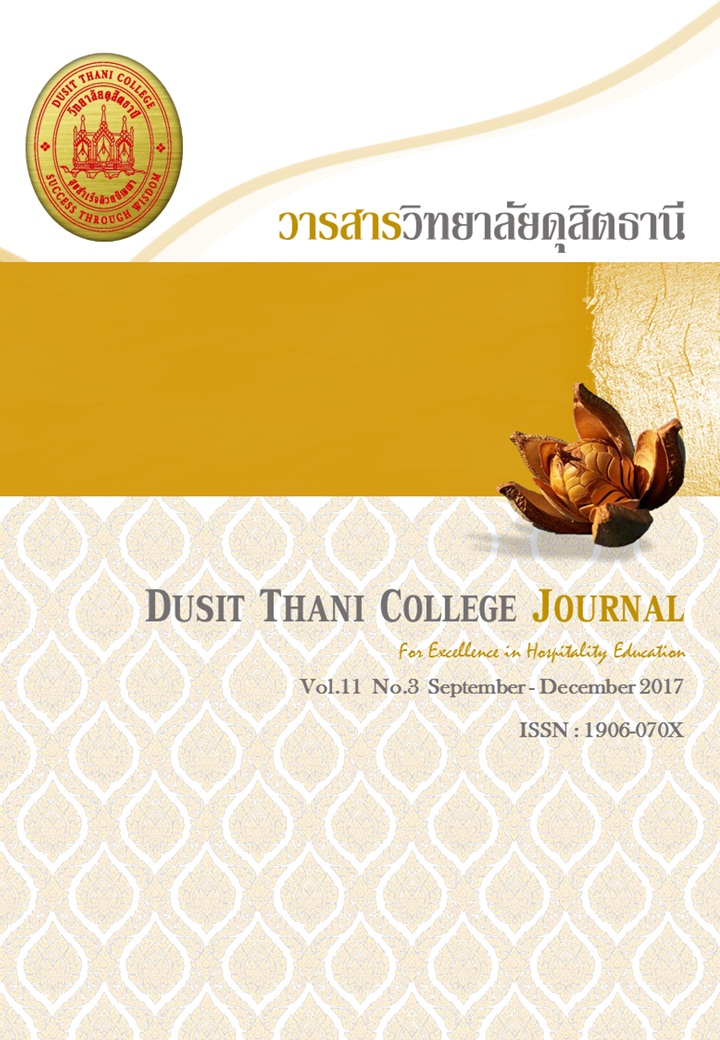The Relationship between Utilization and Gratification, Lifestyle and Behavior on Multiscreen Media Uses of Middle Class User in Bangkok Metropolis
Main Article Content
Abstract
The research objectives are: 1) to study the differences between demographic factors and behavior of middle class users with multiscreen media usage in Bangkok Metropolis, 2) to study the relationship between lifestyle and behavior of middle class users with multiscreen media usage in Bangkok Metropolis, 3) to study the relationship between behavior of multiscreen media usage and utilization and gratification’s behavior of middle class users with multiscreen media usage in Bangkok Metropolis and 4) to study the relationship behavior of multiscreen media usage and gratification’s behavior of middle class users with multiscreen media usage in Bangkok Metropolis. By using the survey research technique and online questionnaires, the study collected a sample of 350 middle class users in Bangkok Metropolis who had income between 10,000 - 49,999 Baht per month, aged between 18 - 60 years old, and took the diploma to bachelor degrees.
The result found that majority of respondents included female who was aged between
18 – 24 years old with the bachelor degree and worked for public organizations, and had income between 10,000 - 19,999 Baht per month. Behavior of multiscreen usage part indicated that the respondents generally used the smartphones and the three main categories of multiscreen media included Multi-tasking (Unrelated activity), Complementary Usage (Related activity) and Sequential Usage and these three main categories implied that the degree of behavior toward using multiscreen media was moderate which socialization and travelling represented the highest mean value and the frequent use was when being on the travel. Furthermore, the bed room and living room were the place that respondents had spent most of their time using the smartphone. The main purpose of using the multiscreen media was to communicate with other people and to keep updating the news more conveniently. Moreover, the majority of respondents satisfied with the use of multiscreen media due to their benefits to daily life.
Article Details
Article Screening Policy
- All research and academic articles to be published must be considered and screened by three peer reviews in the relevant field / article.
- All articles, texts, illustrations and tables published in the journal are the personal opinions of the authors. Editors don't always have to agree. And no responsibility whatsoever is the sole responsibility of the author.
- The articles to be published must never be published. Where did you first publish? And not in the consideration of other journals If the audit found that there has been a duplicate publication It is the sole responsibility of the author.
- Any article that the reader sees as being plagiarized or impersonated without reference. Or mislead the work of the author Please let the journal editor know it will be your greatest blessing.
References
Chuastapanasiri, Time. (2014). Multiscreen Multiplatform. 4PM.
College of Management Mahidol University. (2013). Marketing Conference No.11. Retrieved from https://inside.cm.mahidol.ac.th/mkt/attachments/533_MK%20CMMU%20-%20The%20Masstige%2010-01-2013.pdf
Electronic Transactions Development Agency (Public Organization). (2015). Thailand Internet User Profile 2015. Retrieved from https://www.etda.or.th/publishing-detail/thailand-internet-user-profile-2015.html
Electronic Transactions Development Agency (Public Organization). (2016). Thailand Internet User Profile 2016. Retrieved from https://www.etda.or.th/publishing-detail/thailand-internet-user-profile-2016-th.html
Google. (2012). The New Multi-screen world: Understanding Cross-platform Consumer Behavior. Retrieved from https://www.google.com/think/research-studies/the-new-multi-screen-world-study.html
Interactive Advertising Bureau (2015). The Changing TV Experience: Attitudes and Usage Across Multiple Screens. Retrieved from
https://www.iab.net/media/file/The_Changing_TV_Experience.pdf
Kiatkanarat, Sorn. (2014, Mar 5th). Innovative Activation, Multi-Screen Engagement. Retrieved fromhttps://www.facebook.com/marketeermagazine/photos/a.115858001799638.16551.110111112374327/696660683719364/?type=3&theater
Kriangchaiyaporn, Nateerai. (2000). Lifestyle of Male Consumers in Bangkok. (Thesis, Master of Communication Arts, Chulalongkorn University).
Microsoft Advertising. (2013). Cross-Screen Engagement: Multi-Screen pathways reveal new opportunities for marketers to reach and engage consumers. Retrieved From https://advertising.microsoft.com/uk/WWDocs/User/display/cl/researchreport/1932/global/Cross_ScreenWhitepaper.pdf
MillwardBrown. (2014). AdReaction 2014 Marketing in the multiscreen world Global Report. Retrieved from https://www.millwardbrown.com/adreaction/2014/report/Millward-Brown_AdReaction-2014_Global.pdf
Nielsen Thailand CMV. (2015). Thailand Multiscreen Behavior. Tharn Settakij, 18.
Prachachat Turakij Online. (2015, Jan 30th). “Smart device” ครองใจคนเมือง ธุรกิจขยับรับ เทรนด์ “สังคมก้มหน้า”. Retrieved from
https://www.prachachat.net/news_detail.php?newsid=1422505708
Prajongsangsri, Kanokkarn. (2014, Feb 28th). Mutiscreen Behavior - Multi Platform. Krungthep Turakij.
Rittherawee, Kijthawat. (2015, Jul 31st). Multiscreen Behavior of Consumer. Krungthep Turakij.
Siriyuwasak, Ubonrat. (2007). Communication, Mass Communication and Mass Media. Bangkok: Chula Press
Srivanasont, Penchawee. (2013). Generation Y’s Motivation and Behavior on Multiscreen Media Uses. (Thesis, Master of Communication Arts, Chulalongkorn Universiry).
Think with Google. (2015, July). 4 New Moments Every Marketer Should Know. Retrieved From https://www.thinkwithgoogle.com/infographics/4-new-moments-every-marketer-should-know.html
UM Wave 8. (2014). “Wave 8 – The Language of Content”. Retrieved from
https://wave.umww.com/assets/pdf/wave_8-the-language-of-content.pdf
Yindee, Prapasri. (2009). High School Adolescent Boy’s Lifestyles. (Thesis, Master of Arts, Silpakorn University).


